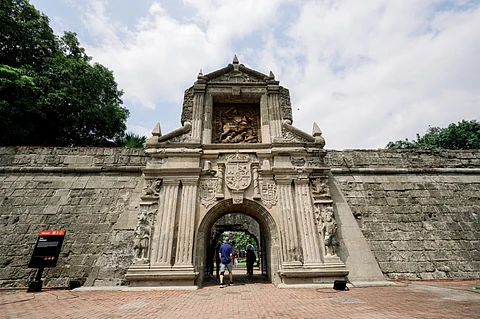
- NEWS
- the EDIT
- COMMENTARY
- BUSINESS
- LIFE
- SHOW
- ACTION
- GLOBAL GOALS
- SNAPS
- DYARYO TIRADA
- MORE

Kärcher, a German company famed for its cleaning technology recently undertook a restorative cleaning activity at Fort Santiago, particularly sections of the main gate, the Baluartillo de San Miguel and Medio Baluarte de San Francisco.
The initiative, done in partnership with the Intramuros Administration (IA), is part of the company’s 90th anniversary this year in which it will be undertaking cleaning projects in 90 historic sites around the globe.
The activity is also done in connection with the 80th anniversary of the end of World War II in which Fort Santiago and Intramuros in general, were part of.
Darwin Banez, general manager of Kärcher Philippines said its partnership with IA is “is instrumental to this initiative’s success, enabling us to honor the memory of war victims and celebrate Filipinos’ heroic sacrifices.”
Fort Santiago is the latest site in Metro Manila cleaned by Kärcher through its high-pressure cleaners.
It previously cleaned the Rizal National Monument in Ermita (2017), EDSA People Power Monument in Quezon City (2018), San Agustin Church and Monastery (2019), Plaza Miranda in Quiapo (2020), Bonifacio Shrine in Ermita (2021), Minor Basilica of San Sebastian in Quiapo (2022), and Saint Andrew’s Cathedral in Parañaque (2024). Additionally, it cleaned the church of Silang in Cavite in 2023.
Banez said the goal of this undertaking is “not only to clean but also to help preserve historic and culturally significant landmarks around the world.”
He said that “this initiative aligns with the growing awareness among Filipinos about the importance of heritage conservation.”
“The removal of organic growth and black crusts helps protect these monuments for future generations while allowing restorers to assess and address structural damage more effectively,” he added.
Banez further elaborated that a cleaning project like that of Fort Santiago requires a painstaking process and collaboration with property owners.
“Each project undergoes meticulous planning over approximately two years and is executed in close collaboration with monument owners, conservators, restorers, and art historians to ensure the safest and most effective preservation techniques are used,” he said.
For her part, IA administrator Joan Padilla said the project further exposes the grandeur of the fortification which was begun to be built in late 16th century.
“This initiative has reminded us that we are not alone in our mission to revive and protect the cultural and built heritage of our Walled City,” she said.
“It is through collaborations like this that we are able to ensure that these walls, these fortifications, continue to stand proud — not just as remnants of the past, but as vibrant symbols of our future,” she added.
Trained IA personnel helped in the cleaning project while IA received a donation of a cleaning equipment from Kärcher.
Daina Bartuseviciute of Kärcher Southeast Asia meanwhile said the goal of the project is ensuring the long-term preservation of the walls by preventing floral growths which affect the integrity of the stone. This is apart from enhancing the site’s appearance.
“For this project, we are using Kärcher’s steam cleaning technology — a gentle, chemical-free method that effectively removes dirt, pollution and biological growth while keeping the original structure in its best condition,” he said.
Also done to mark Kärcher’s 10th anniversary in the Philippines, the project is part of the company’s corporate social responsibility and thrust of preserving significant sites around the world.
“Together, we are ensuring that Fort Santiago remains a proud symbol of Philippine history for many years to come,” he said.
The cleaning of Fort Santiago also marks a historic event in Philippine-Germany relations as it marked its 70th anniversary last year.
David Klebs of the German Embassy said that these projects “stand as a shining example for the dynamic and multifaceted relationship of our two countries.”
“Kärcher’s dedication to preserving historical sites is a testament to Germany’s commitment to cultural heritage worldwide,” he said.
Founded on 2 January 1935 as a workshop for heating technology in Germany, Kärcher has evolved into a global brand for cleaning technology.
It utilizes, fully automated cleaning robots and cleaning devices controlled through an app in its cleaning projects.
To date, it has cleaned more than 200 sites globally including the aforementioned sites in the Philippines.
Conservation-wise, its cleaning method is not invasive to the structure nor the materials used.
The company said that its “dedication to cultural heritage is reflected in its meticulous approach and innovative cleaning technologies, ensuring that each project respects historical significance.”
